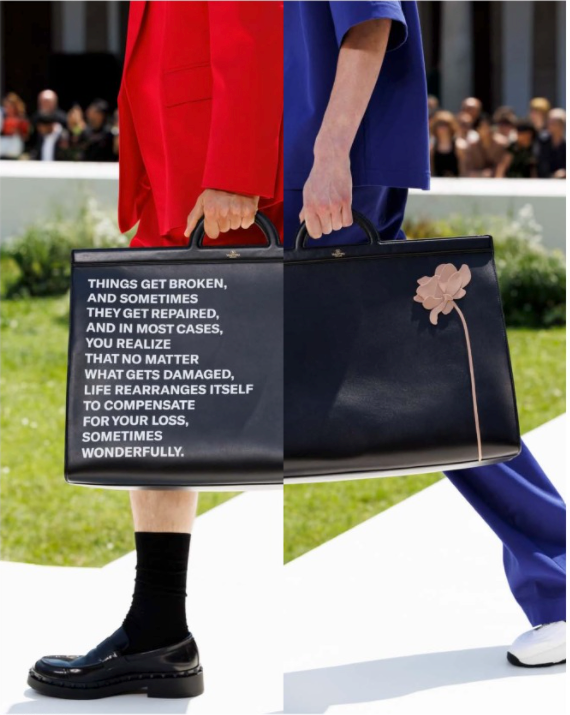The quote from ‘The Devil Wears Prada’ immediately rang in my head after seeing Valentino’s signature Men’s collection for Spring Summer 2024 on the runway, which is, indeed, permeated with an endless variety of flowers. Do flowers seem trivial to you in spring? Yet, they manage to leave you breathless. Yep, Pierpaolo Piccioli has done it again. He also amazed us with his first runway show dedicated entirely to men’s fashion.
Piccioli, before being named ‘Best Fashion Designer’ in 2022 by the British Fashion Council, took acerbic steps in 1989 by taking charge of Fendi’s accessories division, paired with another rising star, Maria Grazia Chiuri.
For both of them a common trait: an out-of-the-ordinary personality, capable of respecting the tradition of a brand while feeding it with new sap, vital, that knows how to nourish taste with the values of today.
A topicality that for Piccioli’s Uomo was manifested in a fabulous show held last June in the main courtyard of Milan’s Statale University. A day like any other for the students who came across designer garments and an abundance of style. In fact, a clear sign, capable of screaming Piccioli’s not casual choice to commit, long ago, to make fashion more democratic (within the usual, inevitable limits). Already in Paris he took models outside the sacred thalamus of the catwalks, after the fashion show. He took them to the street for the benefit of anyone who felt like browsing. Personality, it was said. Ideas, principles and strength to make them concrete gestures, inspiring others, starting, for example, with Diesel.
When Piccioli and Chiuri moved to Valentino in ’99, would you have bet that step by step the designer, even after she went to get Dior, would revolutionize the brand, while not raising his voice too much?
That he would have had the courage to flank the legendary, iconic and historic Valentino Red with a new pantone, the now ubiquitous Pink PP (and Barbie had nothing to do with it, I assure you)?
Maybe we wouldn’t have played any chips, but his personality would have gone ‘all-in’.
For there is no denying the innovative spirit of this designer, who in his first men’s fashion show had the strength not only to put forward his ‘democratic’ approach, but also to suggest an idea of masculinity capable of uprooting the age-old oaks of the well-meaning. Classic blazers with stiff cuts were softened and paired with shorts and short skirts; disproportionate flowers appeared on jackets and shirts or glimpsed small and embroidered on lapels. Colors, Piccioli’s signature trait, were also limitless: from neutrals to brighter ones, such as mint green and turquoise, without forgetting the total-look in Pink PP.
I am a woman, but I would have loved to wear every single look that appeared on the runway. And this is precisely the magic that a personality like Piccioli’s is capable of: transforming flowers in spring (what could be more banal, let’s admit it) into a manifesto that embodies the deepest desires of the new generations; creating a fluid and genderless Man collection capable of appealing to anyone, because at once extraordinary and simple.
The Valentino Man imagined by Piccioli exposes himself without hiding anything, his rocky features as well as crumbly paths. Strength and fragility. He is a man no longer constrained to be strong, imperturbable, an expression of power, but can allow himself to be sweet, weak and sensitive.
That is why the collection was titled “The Narratives,” because everyone can tell himself and his own story through the garments he wears.
If you are among the lucky ones who received an invitation to the fashion show, you will also have been delivered a copy of the book ‘A Little Life’ by Hanya Yanagihara, with a pink cover (ça va sans dire).
From that novel Piccioli drew the deeper meaning of his first men’s collection.
Four young men face life’s difficulties by composing a disorienting, magnetic and realistic story that, once read, does not allow you to turn back. The tale takes root inside the reader after beating him or her with mixed emotions. Perhaps that is why the designer could not help but bring back some quotes from it on different garments. The most recurrent: “We are so old we have become young again.”
We would listen to Piccioli for hours as he read the pages of that book. Because it is good to engage with a ‘respectful innovator’ who promotes collaboration and inclusiveness. Who fights for true and concrete freedom to be yourself, whoever you are, by putting his talent, his creations, his personality to good use.
Because freedom, he tells us with the garments of ‘The Narratives’, is not having to repress or hide any nuance of who you are.



